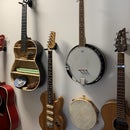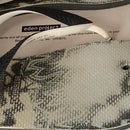Introduction: Beat Drop - Acoustic Finger Drumkit
This project is an awesome 2 hour project that has a huge payoff. I spent the morning making it and the rest of the afternoon continuously tweaking it and figuring out how to play through the various dynamics of it. To me, this little thing packs more of a punch then my diy Cajun. I think it's fast becoming one of my new favourite instruments (and I have a fair few).
So... I got the idea of making an egg shaker when a tree at work dropped thousands of hard seeds on the car park. I collected a couple of pockets full and put them in my plastic lunch container. Once I had done this, I realised that it sounded a lot like a snare when I hit it. I decided to make a little wooden box to put them in as a foot snare as opposed to the stomp box which worked like a kick drum. That way I could play both and have a basic kick and snare sound. I decided to amplify the sound using a piezo element and speaker from an old pair of crappy headphones.
Turned out that this worked super well.
For this project you will need:
Some wood
Wood glue
Some seeds, rice, wheat or lentils
A piezo element or piezo buzzer
Some old headphones (optional)
A 1/2 inch jack
Some wires
Soldier
Tools needed:
A router or chisels
A jigsaw, coping saw or band saw.
Clamps
Soldiering iron
Step 1: Woodwork
For the main body, you will need two pieces of wood. I used ply because that's what I had, but solid timber probably has some nice tonal qualities that make it worthwhile.
I marked out the circle using a paint can. And left the right angle corner that was already there. I cut out the shapes using a jigsaw.
I then drew around the piezo and the jack connector. I marked out the size of the compartments.
I theorised that the bigger holes would have a deeper tone, so I used the router and cut the larger holes deeper to make them larger. The effect of this was that the wood became thinner and this actually created higher pitches. The solid timber had more of the bass sound.
I planned to try halve the size of the hole each time, but it was all pretty much guess work.
I made them as even as I could on both halves remembering to mirror the sides so they would come together cohesively.
Step 2: Electronics
A Piezo element is really all you need for this, but I thought I would be clever and wire an old headphone in as well. This may play a small role in creating some of the higher pitched sounds.
The wiring is simple. There is hardly a wrong way to do it.
One goes to the tip of the jack and one goes to the sleeve. (So one wire of the piezo goes to each)
Same thing for the headphones. It works the same no matter which way you wire it.
Some people have suggested that having two piezo elements and wiring them opposite to each other helps to get rid of any ground hum. So you could try that out.
Step 3: Gluing and Texturing
The next thing was to pour the glue all over the connecting edges, pour seeds in the holes and clamp them both together.
One the glue is dry, you need to finish them off.
I intentionally made cut side larger so that I could use my router with a bearing bit and trim the edges to exactly match the one. You could make both slightly large and do the same with a band saw or jigsaw.
I then sanded it down.I used really dirty and crappy scrap ply, so I attacked it with a belt sander to get it tidied up. Unfortunately the belt slipped and shredded half way through sanding.
What this created was a really rough sanded finish rather than a smooth sanded finish.
I was eager to have a play with it so I plugged it in and had a jam at this stage. It turned out that sliding the finger over the board created some really cool sounds brush like because of the rough unevenly sanded surface. Using the fingernail creates sounds similar to a record scratch.
I then got the idea of using the wood burner and some chisels to make lines and grooves to further enhance this. The smooth burnt wood has a squeaky sound and you can slide across the carved grooves with finger nails to get a kind of cricket croak. The different textures create different types of sounds to explore.
Step 4: Jamming
Once I had a jam for a while, I figured out a few different techniques that seem to work.
First, I marked out where the piezo was. Hitting directly on the piezo gives a nice bass thud.
On the edge by the piezo gives a nice thick snare.
Hitting the larger pad on the edge near the piezo with a fingernail gives a rimshot sound.
Flat fingers on any part of the drum gives a snare sound.
Scratching with the fingernails gives a record scratch sound.
Sliding with fingers gives a jazz brush snare.
Shaking is like a rattle.
Tilting it can give the rain maker sound.
Depending where you hit, you can get a great variety of snares.
If you wet your fingers you can slide them across like an Indian tabila and get a hum. (Especially on the burnt smooth part.)
Stomping on it gives a snare sound.
Playing on the reverse side gives a slightly duller, but more treble sound.













